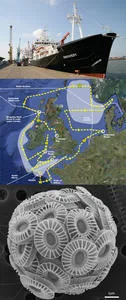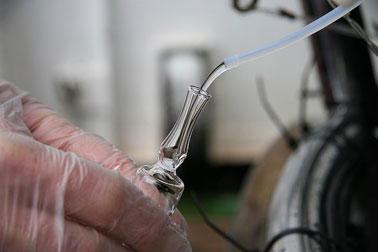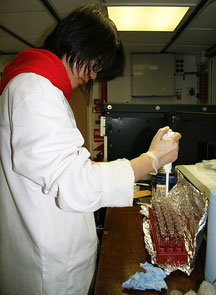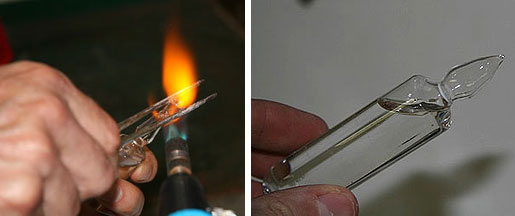
Today is the penultimate day of scientific data collection for most of us. At 5am we measured the last of the bottles from the fifth and last bioassay. Then, a few hours later, the CTD was lowered down on the start of another long journey to the deep ocean.
We have steamed out westwards to an ocean area known as the Rockall Trough, a deepwater channel west of Scotland connecting the Norwegian Sea to the northeast with the Atlantic Ocean to the southwest. This is the second time on this cruise (the first was in the Bay of Biscay) that our track has taken us out into very deep water, with several kilometres of water between us and the seafloor.

Polystyrene cups were again attached to the CTD (see 21 June blog). The last time that we did a deep CTD station, the CTD suffered a failure, but this time all went well and the CTD was successfully raised from the depths together with its complement of water collected there.

We took advantage of this deep CTD to collect some stable, deep water to make ‘standards’ with. The word ‘standard’ here is used in a sense that has nothing to do with ethics or acceptable behaving or recommended procedures. In this case the word is used in the sense of benchmarks or comparators. A standard in this scientific sense is something with a known and trustworthy value.

Standard weights and measures used to be used in order to keep shopkeepers honest, to make sure for instance that when they said they were selling a kilogram of flour that they actually were. In past times standard weights used to be available that could be put on one side of a set of scales to check that shop weights agreed with their claimed values. Examples of standard lengths used to be embedded in the corners of churches, to ensure agreement on units. Today the international reference standard for a kilogram mass is a block of platinum-iridium held at the Bureau International des Poids et Mesures in France. Still today each country has an organisation responsible for enabling measurement accuracy.
For much of the scientific data that we collect, it is vitally important to be able to check that the instruments being used are returning valid results. To this end, a variety of standards are used. For instance, little pots of seawater can be obtained which have a known acidity (pH), and these are used to calibrate pH measurements. Likewise small vials of precisely known chlorophyll concentrations can be ordered, and these are used to check that our measurements of chlorophyll concentration are correct and meaningful.
So today we filled approximately one thousand small ampoules (vials) with seawater from a depth of nearly two kilometres. These will be our self-made standards for dissolved organic carbon (DOC) measurements (see last blog entry), which we will use in conjunction with other standards purchased from elsewhere. We used deep water because not much lives in it, and as a result it is chemically rather stable and constant. After filling each ampoule, acid was added to remove inorganic carbon and kill any remaining organisms that were there. In a last step, the tops of the ampoules were sealed using a glass-blowing technique (see photos). The tops were melted and folded over to make an airtight seal, to prevent any possibility of contamination until they are broken open at some future date. Once we are back in the lab, several ampoules will be cracked open and the precise DOC value of several of the ampoules will be obtained very carefully (they will all have the same value). After that, in future the rest can be used as standards.
Although it was quite a laborious process, these standards will help ensure the high quality of the DOC measurements from this cruise and others.
A highpoint today was a sighting of two or three pilot whales in the distance, although we didn’t get to see them at close range.